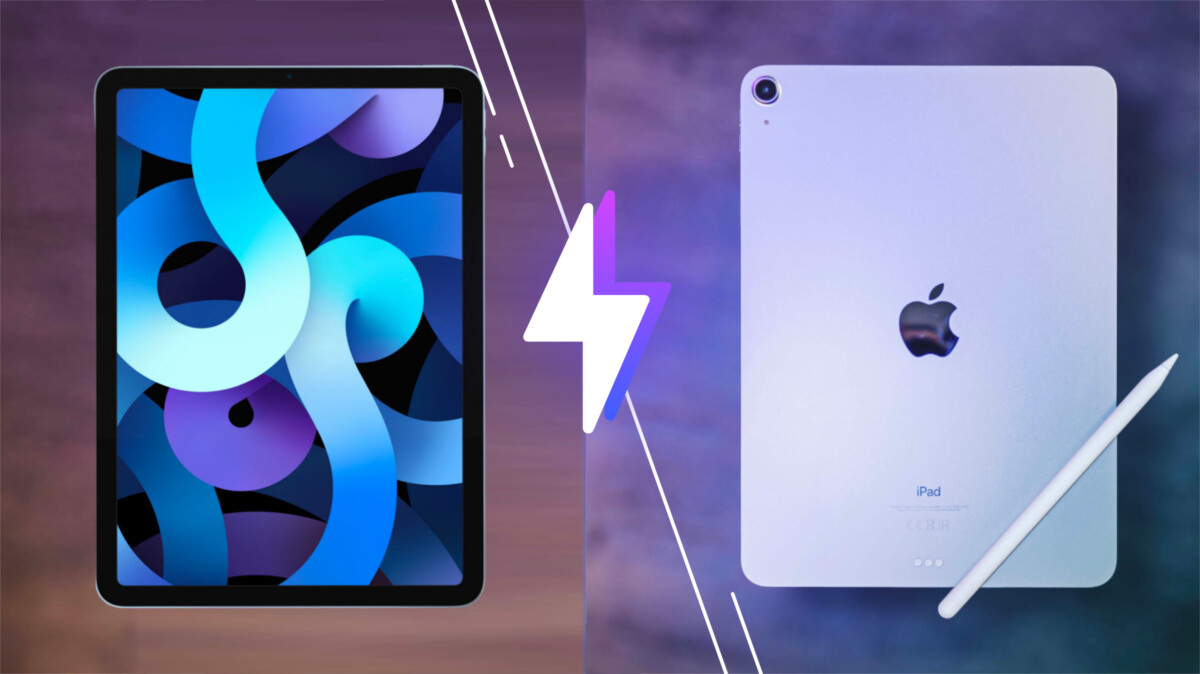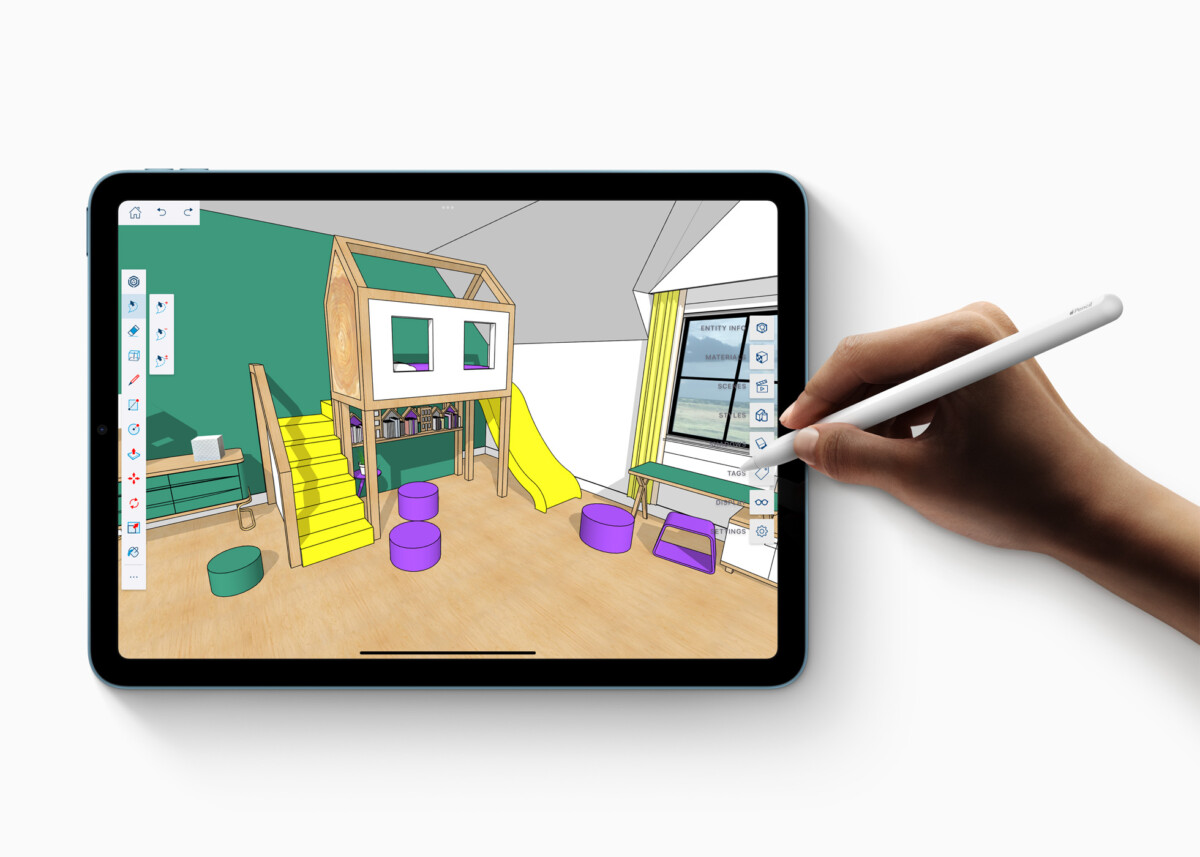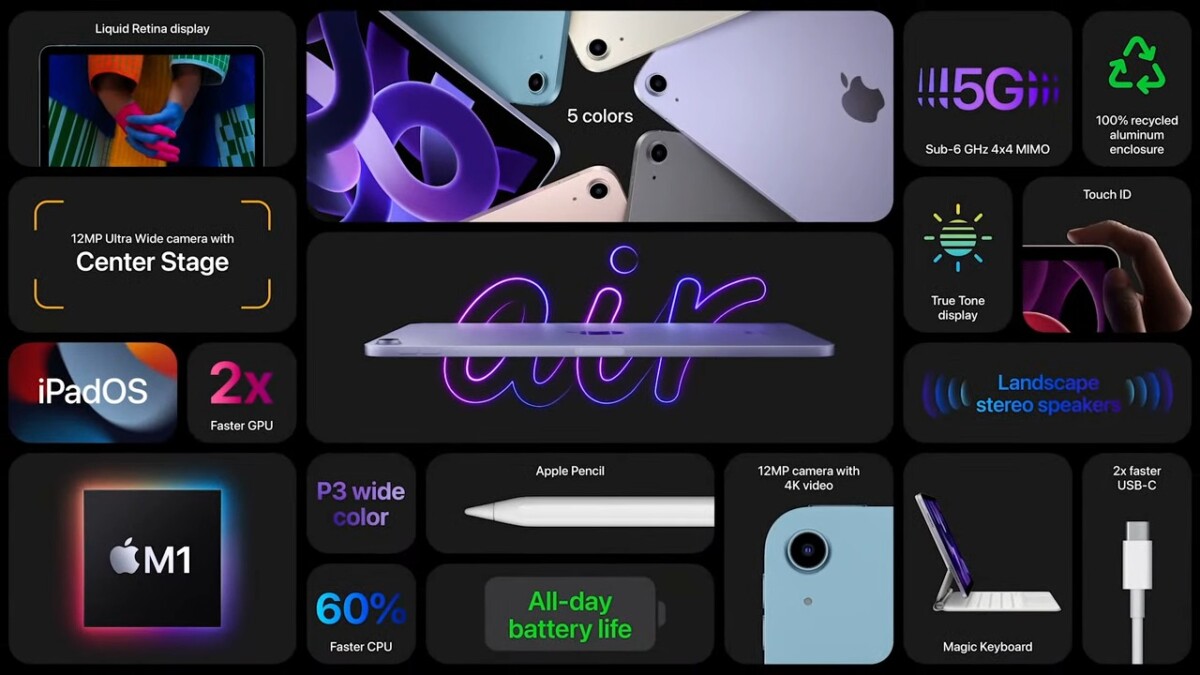By unveiling its new iPad Air with M1 chip on Tuesday evening, Apple is homogenizing its range of touch pads towards the top of the range. This is one of the few major changes in the lighter new vintage. Is it worth eliminating the old iPad Air model from your mind at the time of purchase? Not necessarily…

iPad Air M1 or iPad Air 2020? // Source: FRANDROID
All new, all beautiful. The new iPad Air was expected and it showed well during the first keynote. It comes with some notable changes (M1 chip, FaceTime camera with ultra-wide-angle sensor, new colors in particular), but no revolution as was the case between the last two models. And above all, a price that is rising again compared to the iPad Air 2020 and which leaves a gaping hole in Apple’s price list between the iPad (9th gen) and the iPad Air 2022.
If Apple therefore no longer markets the iPad Air 2020, it remains commercially available and its price will necessarily suffer a slight drop. What still make it an interesting investment if you are looking for an effective iPad. Here is our comparison to be able to judge according to your desires and needs.
Design and screen: Siamese
You don’t change a recipe that works. The iPad Air 2022 is the exact copy of the iPad Air 2020 (24.76 cm x 17.85 cm x 6.1 mm). We find the same chassis with straight edges with rounded corners to look like the iPad Pro. The borders are still less thin than those of the very high-end model from Apple. The Touch ID button remains present, but on the edge, embedded in the ignition-exit standby button. Apple has once again opted for two speakers with panoramic sound and not four as on the iPad Pro.
The iPad Air features the same 10.9-inch Liquid Retina screen with anti-fingerprint and anti-reflective coating, taking advantage of the True Tone function (2360 x 1640 pixels, 264 ppi), with an SDR brightness of 500 nits maximum. You benefit from exactly the same sensors (gyroscope, accelerometer, GPS, etc.), a simple USB-C port for recharging and the Smart Connector to optionally add a magnetic keyboard or a cover.

The design of the iPad Air M1 remains the same // Source: Apple
The only difference that can be noted concerns the weight and a very small catch of three grams in the Wifi version for the 5th generation iPad Air (461 g) and two grams in the 5G version (462 g).
You can also use the Apple Pencil 2nd gen (optional) to write, draw, annotate, etc. And both devices can take advantage of iPadOS 15 which will obviously be natively installed in the new iPad Air with the latest update available at launch.
To know everything about the design of the device, you can go to the part devoted to this point in the test of the iPad Air 2020.
Power and Storage: the big leap forward
If there’s a size difference between the 4th and 5th generation Apple tablet, it’s there: in the chip. The iPad Air 2020 could already boast of the A14 Bionic chip, the same as that of the iPhone 12 with a 64-bit architecture and the onboard Neural Engine. When it was released, this made it a much better served competition beast than the 2020 iPad Pro.

Source: Apple
For its 2022 version, Apple has put the dishes in the big ones. The iPad Air now features the M1 chip, Cupertino’s competition monster that powers the iPad Pro and, in various versions, the MacBook Air and Pro, the latest iMac and the Mac mini. Here, there are 8 CPU cores and as many for the GPU, with a latest generation Neural Engine, accompanied by 8 GB of RAM (for the iPad Pro, this can go up to 16 GB depending on the configuration).
| Model | Apple iPad Pro 11 M1 | Apple iPad Air 2020 |
|---|---|---|
| AnTuTu 8 | 1114146 | 633932 |
| AnTuTu CPU | 265230 | 183696 |
| AnTuTu GPU | 544006 | 265584 |
| AnTuTu MEM | 199337 | 88704 |
| AnTuTu UX | 105573 | 95948 |
| 3DMark Wild Life | 18263 | 6564 |
| 3DMark Wild Life average framerate | 109 FPS | 39 FPS |
| GFXBench Car Chase (onscreen/offscreen) | N/C | 40 / 85FPS |
| GFXBench Manhattan 3.0 (onscreen/offscreen) | N/C | 52 / 199 FPS |
See more benchmarks
Suffice to say that there will be power to spare in this iPad Air which has just flirted with powerful home touch pads. This also tends to move its center of gravity towards the very high end, whereas until then it wanted to be an alternative between the iPad and the iPad Pro, both in terms of proposal and price. But nothing can escape you (if that was already possible with the A14 chip…), even the most demanding games, video editing of 4K streams, etc.
Both tablets are offered with 64 GB or 256 GB of storage. The first option remains, in our opinion, a bit tight if you plan to have significant use (storage of photos, music, videos, documents, etc.). The second raises the price and, in this, the iPad Air 2020 has assets to advance.
Photo and video: for fans of video calls
This is one of the main differences between the two models: the FaceTime camera on the front.
The iPad Air 2020 has a rather efficient 7 Mpx (f / 2.2) wide-angle device which also benefits from Apple’s software optimizations for a rather efficient rendering in video calls.
The iPad Air M1 goes upmarket. Like the iPad Pro, the iPad Mini and now the latest 9th generation iPad, it swaps its old photo sensor for a brand new 12 Mpx sensor with ultra-wide-angle lens (122° field of view, f/2, 4). The quality is obviously improved, also benefiting from the processing power of the M1 chip. But above all, it benefits from the Centered Frame function.

The FaceTime camera’s Center Frame feature expands the field of view to follow you or everyone in // Source: Apple
If you have frequent video calls, this function, and the upscaling of the sensor, will delight you. It can obviously be deactivated if the incessant movements of the camera, especially if you are on the move, end up tiring you. But the rendering for your professional videoconferences or your calls between friends and family is excellent. An argument for some.
On the back, on the other hand, the iPad Air still has the same single 12 Mpx wide-angle camera (f / 1.8) with Smart HDR 3, capable of filming in 4K at 24, 25, 30 or 60 frames per second, with 3x video zoom and support for slow motion in 1080p (120 or 240 fps) as well as accelerated image with stabilization. The only new feature is extended dynamic range for video up to 30 fps like on the iPad Pros (same support on the FaceTime camera).
Connectivity: 5G on the agenda
If Wi-Fi 6 is still there as well as Bluetooth 5.0, it is on mobility connectivity that times are changing. The new iPad Air now has a 5G model when the iPad Air 2020 was capable of service on 4G. This is a big change for those who take advantage of a 5G network near their home and who plan to walk around their iPad Air often.
This one also takes a little more Gigabit LTE bands (32 against 30, but availability depending on country).
The choice of colors
The iPad Air M1 is enriched with new colors. There is now a brand new Mauve (identical to that of the iPad mini), a Starlight (light gold) which replaces the Silver version and a new blue a little darker than the old one. The Rose Gold lightens a little and becomes Rose. Exit the green on the other hand which remains the prerogative of the 4th generation. The iconic Space Gray is still there. These are therefore the same colors as those available for the iPad mini, blue as a bonus.

The new colors for the iPad Air (5th gen) // Source: Apple

The colors of the iPad Air 2020 // Source: Apple
iPad Air prices and availability
The new iPad Air M1 will go on sale on March 18. Pre-orders begin this Friday, March 11 at 2 p.m. The new tablet starts at 699 euros in the wifi version with 64 GB of storage to reach 869 euros in 256 GB. For the 5G model, count 869 euros in 64 GB and 1039 euros in 256 GB.
You will no longer find the iPad Air 2020 on the Apple site, it has already been replaced. But there are other retailers. It is still sold for example on Amazon, Boulanger, Darty and many others, at a price often slightly lower than its starting price (669 euros). But past the launch of the new model, it should be even more affordable.
If the difference remains 30 euros, there is obviously no picture and, to be ready for a few years, jump on the iPad Air M1 if you had not put the iPad Pro in your sights. If its price falls around or even below 600 euros, the iPad Air 2020 could become a very good alternative to the iPad Pro and reinforce its status as excellent value for money. The A14 Bionic chip is still very powerful, much more than that of some smartphones, to meet all your productivity, creativity, mobile gaming or streaming needs. If you don’t want to invest in an iPad Pro model for its power, dual camera or size (it comes in 11 and 12.9 inches), then the iPad Air M1 will get you a good saving (about 140 euros on the 256 GB model).
To follow us, we invite you to download our Android and iOS application. You can read our articles, files, and watch our latest YouTube videos.

